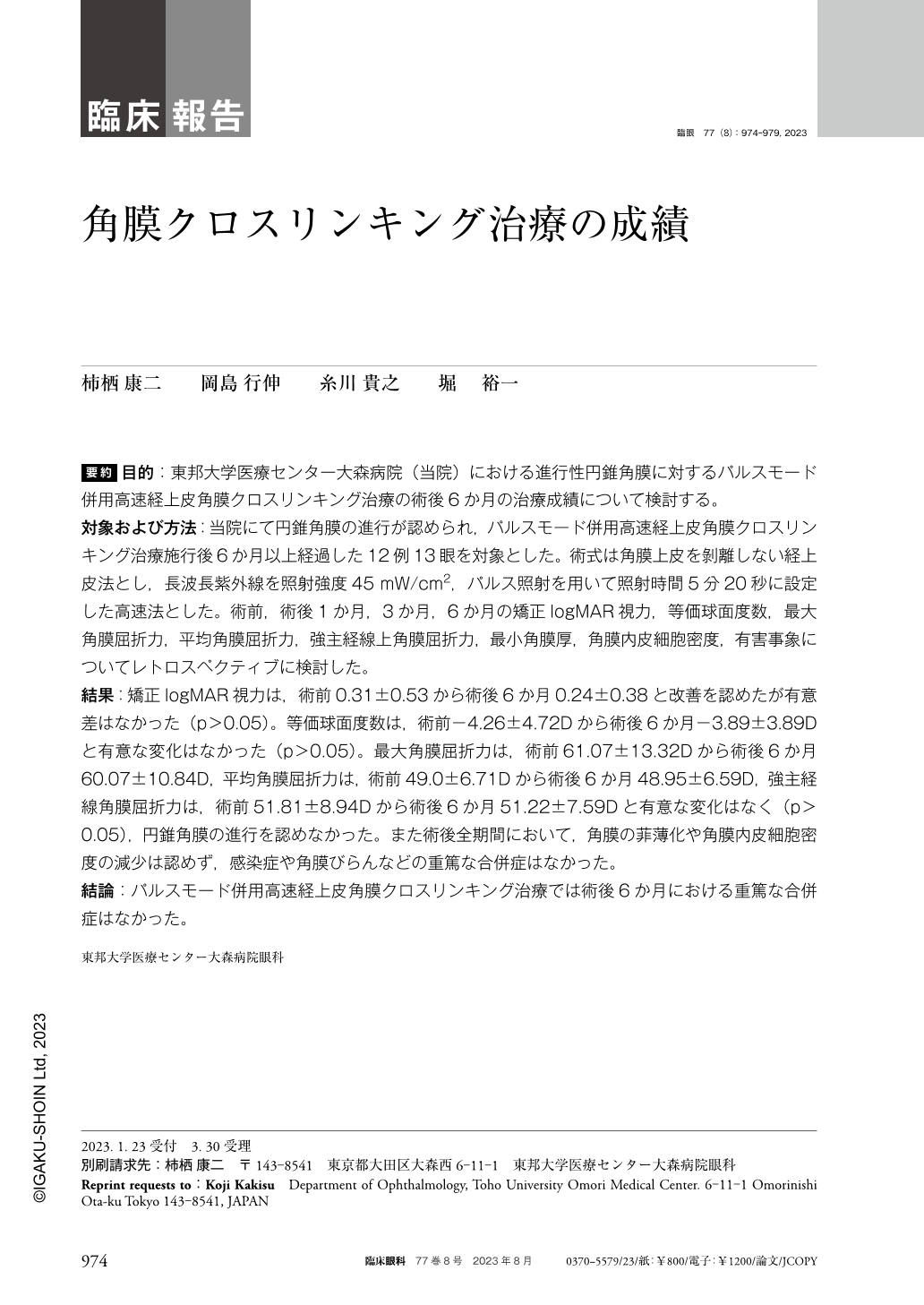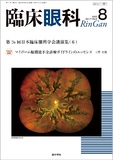Japanese
English
- 有料閲覧
- Abstract 文献概要
- 1ページ目 Look Inside
- 参考文献 Reference
要約 目的:東邦大学医療センター大森病院(当院)における進行性円錐角膜に対するパルスモード併用高速経上皮角膜クロスリンキング治療の術後6か月の治療成績について検討する。
対象および方法:当院にて円錐角膜の進行が認められ,パルスモード併用高速経上皮角膜クロスリンキング治療施行後6か月以上経過した12例13眼を対象とした。術式は角膜上皮を剝離しない経上皮法とし,長波長紫外線を照射強度45mW/cm2,パルス照射を用いて照射時間5分20秒に設定した高速法とした。術前,術後1か月,3か月,6か月の矯正logMAR視力,等価球面度数,最大角膜屈折力,平均角膜屈折力,強主経線上角膜屈折力,最小角膜厚,角膜内皮細胞密度,有害事象についてレトロスペクティブに検討した。
結果:矯正logMAR視力は,術前0.31±0.53から術後6か月0.24±0.38と改善を認めたが有意差はなかった(p>0.05)。等価球面度数は,術前−4.26±4.72Dから術後6か月−3.89±3.89Dと有意な変化はなかった(p>0.05)。最大角膜屈折力は,術前61.07±13.32Dから術後6か月60.07±10.84D,平均角膜屈折力は,術前49.0±6.71Dから術後6か月48.95±6.59D,強主経線角膜屈折力は,術前51.81±8.94Dから術後6か月51.22±7.59Dと有意な変化はなく(p>0.05),円錐角膜の進行を認めなかった。また術後全期間において,角膜の菲薄化や角膜内皮細胞密度の減少は認めず,感染症や角膜びらんなどの重篤な合併症はなかった。
結論:パルスモード併用高速経上皮角膜クロスリンキング治療では術後6か月における重篤な合併症はなかった。
Abstract Purpose:The aim of this study was to evaluate the 6-month postoperative efficacy and safety of pulsed-light accelerated transepithelial corneal crosslinking in the treatment of progressive keratoconus.
Subjects and methods:Total 13 eyes 12 patients with progressive keratoconus treated with pulsed-light accelerated transepithelial corneal crosslinking using the KXL® crosslinking device(Avedro Inc, Waltham, MA, USA)were included in this study. Corneal tomographic measurements, best spectacle-corrected visual acuity, spherical equivalent, thinnest corneal thickness, corneal endothelial cell density, and adverse events at preoperative, 1, 3, and 6 months after surgery were investigated retrospectively.
Results:The best spectacle-corrected visual acuity improved from 0.31±0.53 logMAR at baseline to 0.24±0.38 at sixth month, but was not statistically significant(p>0.05). Spherical equivalent did not change significantly from −4.26±4.72D at baseline to −3.89±3.89D at sixth month(p>0.05). Maximum keratometry, average keratometry, and steep keratometry did not change significantly from 61.07±13.32D at respectively(p>0.05). No apparent changes in the thinnest corneal thickness and endothelial cell density and no adverse events were observed throughout the period.
Conclusion:Pulsed-light accelerated transepithelial corneal crosslinking showed no serious complications at 6 months postoperatively, and it may prevent progression of keratoconus.

Copyright © 2023, Igaku-Shoin Ltd. All rights reserved.


